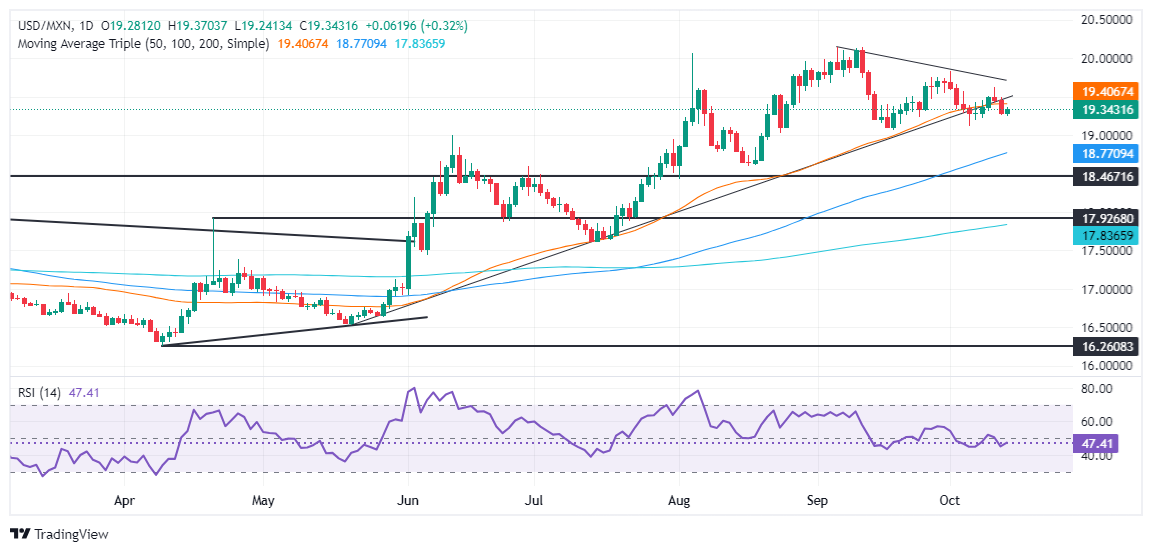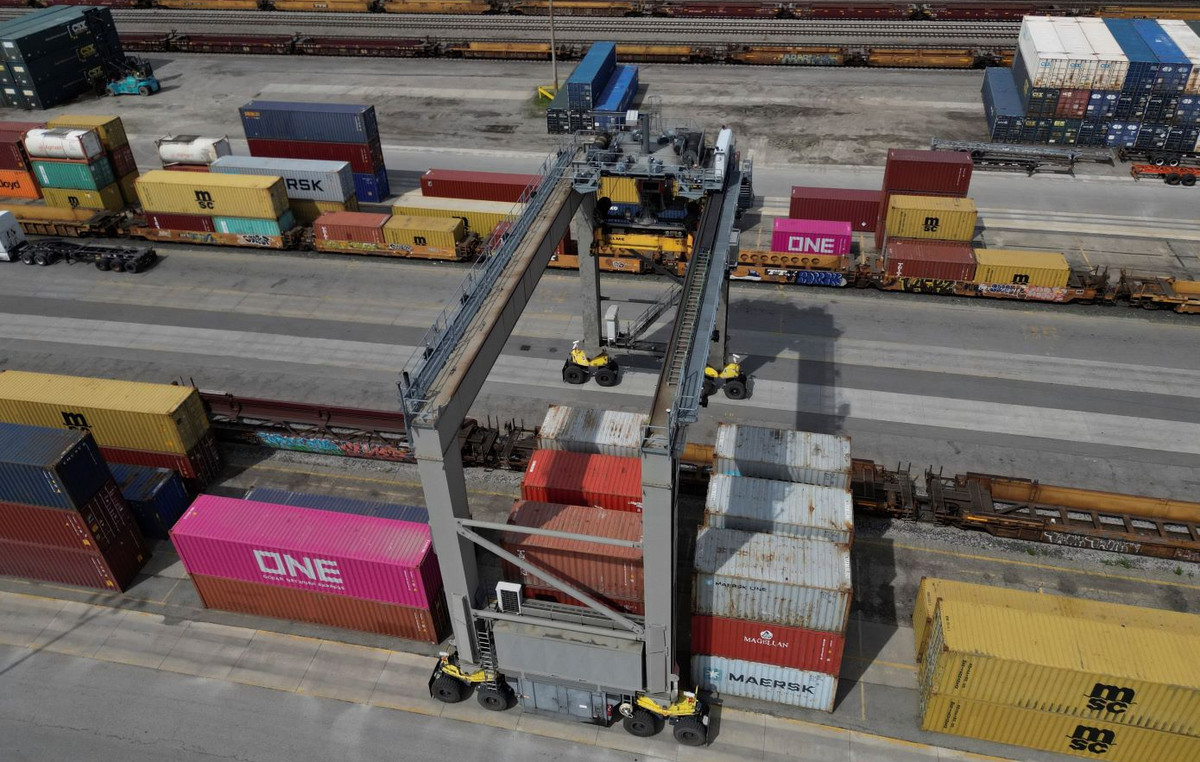- The Mexican Peso weakens 0.51% against the US Dollar with USD/MXN trading at 19.33 as Mexico’s consumer confidence falls.
- Fears over China’s economic slowdown weigh on emerging market currencies, boosting the dollar.
- Former US President Donald Trump hints at 200% tariffs on Mexican vehicle imports, increasing market concerns.
The Mexican Peso depreciated against the Dollar at the beginning of the week and fell more than 0.51%. Weaker than expected data from Mexico, coupled with fears of an economic slowdown in China, weighed on most emerging market currencies and propelled the US dollar higher. USD/MXN is trading at 19.33, up 0.44%.
The National Institute of Statistics, Geography and Informatics (INEGI) revealed that Mexico’s consumer confidence in September worsened and fell compared to August data, which was the highest since February 2019.
Meanwhile, China’s Finance Minister Lan Foan revealed that the government would continue to provide stimulus, support the property market and replenish state-owned banks’ capital in an effort to boost the economy.
China faces intense deflationary pressures caused by a sharp slowdown in the property market and deteriorating consumer confidence.
Former President Donald Trump suggested imposing tariffs of more than 200% on vehicles imported from Mexico, he said in an interview with Fox on Sunday.
In the US, a thin economic agenda left traders adrift, and comments from Minneapolis Fed President Neel Kashkari left them uncertain. Kashkari said he expected “further modest reductions in our policy rate.” He added that recent employment data shows a strong labor market and that the economy is in the final stages of bringing inflation back to 2%.
Later in the week, the US economic agenda will remain light on data, but Fed members will make statements throughout the week. The New York Empire State Manufacturing Index on Tuesday, followed by the Trade Balance on Wednesday and a busy schedule on Thursday could dictate the direction of the USD/MXN pair.
Daily Market Summary: Mexican Peso on the Defensive as USD/MXN Soars
- Mexico consumer confidence in September deteriorated from 47.6 to 47.1. Most subcomponents fell except current conditions compared to a year ago. Additionally, Mexican households revealed that they would be less likely to purchase durable goods, according to the data.
- According to a Banxico survey, the central bank is projected to reduce rates by 50 bps to 10% for the rest of 2024. Meanwhile, the USD/MXN exchange rate is expected to finish near 19.69.
- Mexico’s economy is projected to grow 1.45% in 2024, down from 1.57% in August.
- On Tuesday, the US economic agenda will include the New York Empire State Manufacturing Index for October, which is expected to fall from 11.3 to 2.3, according to estimates.
- Federal Reserve officials, led by Mary Daly of the San Francisco Fed, Board Governor Adriana Kugler and Raphael Bostic of the Atlanta Fed, will make remarks.
- Data from the Chicago Board of Trade via the December federal funds rate futures contract shows investors estimating a 49 bp cut by the Fed by the end of 2024.
USD/MXN Technical Outlook: Mexican Peso Falls as USD/MXN Rises Above 19.30
The USD/MXN bullish trend remains intact, although the pair has failed to surpass the October 10 daily high of 19.61. At the time of writing, momentum supports buyers, as shown by the Relative Strength Index (RSI). However, the pair’s rise could be short-lived unless the RSI surpasses the neutral line of 50.
If USD/MXN rises above 19.50, that would expose the previously mentioned level of 19.61. If broken, the next resistance level would be the October 1 daily high of 19.82, ahead of 20.00. Next would be the annual peak of 20.22.
Conversely, if USD/MXN falls below the October 4 low of 19.10, the 19.00 figure will be exposed. Once broken, the next support would be the 100-day SMA at 18.75.
The Mexican Peso FAQs
The Mexican Peso is the legal tender of Mexico. The MXN is the most traded currency in Latin America and the third most traded on the American continent. The Mexican Peso is the first currency in the world to use the $ sign, prior to the later use of the Dollar. The Mexican Peso or MXN is divided into 100 cents.
Banxico is the Bank of Mexico, the country’s central bank. Created in 1925, it provides the national currency, the MXN, and its priority objective is to preserve its value over time. In addition, the Bank of Mexico manages the country’s international reserves, acts as a lender of last resort to the banks and advises the government economically and financially. Banxico uses the tools and techniques of monetary policy to meet its objective.
When inflation is high, the value of the Mexican Peso (MXN) tends to decrease. This implies an increase in the cost of living for Mexicans that affects their ability to invest and save. At a general level, inflation affects the Mexican economy because Mexico imports a significant amount of final consumption products, such as gas, fuel, food, clothing, etc., and a large amount of production inputs. On the other hand, the higher the inflation and debt, the less attractive the country is for investors.
The exchange rate between the USD and the MXN affects imports and exports between the United States and Mexico, and may affect demand and trade flows. The price of the Dollar against the Mexican Peso is affected by factors such as monetary policy, interest rates, the consumer price index, economic growth and some geopolitical decisions.
The exchange rate between the USD and the MXN affects imports and exports between the United States and Mexico, and may affect demand and trade flows. The price of the Dollar against the Mexican Peso is affected by factors such as monetary policy, interest rates, the consumer price index, economic growth and some geopolitical decisions.
Source: Fx Street
I am Joshua Winder, a senior-level journalist and editor at World Stock Market. I specialize in covering news related to the stock market and economic trends. With more than 8 years of experience in this field, I have become an expert in financial reporting.








